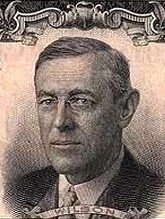In April 1917 United States enter the World War. To pay for this War to End All Wars, the government sells equally oxymoronic Liberty Bonds. A striking feature of these "Liberty Loans" is how the government compels citizens to finance them.
16th amendment authorizes a federal income tax in 1913, and the marginal tax rate rises to 77% in 1918. Liberty Loans are additional money that the government asks citizens to contribute. Patriotic citizens display their support (and show compliance) with buttons on their lapels, emblems in their windows and labels on their mailboxes. Uncle Sam feels quite free to question anyone who does not display these receipts. 75,000 four-minute-men volunteer to sell the bonds locally and check on slackers who avoid doing their bit.
Others volunteer in other ways. Charlie Chaplin produces--at his own expense, all sources agree--The Bond, an 11-minute silent short that shows how bonds of friendship, marriage and liberty all mean that the Trump must pay up.
Title vignette illustrates the bonding process. The Trump gives money to Uncle Sam, Uncle Sam gives money to Industry, Industry gives rifle to Doughboy. According the the War Department in 1917, a rifle and bayonet cost $21.65. The Trump gets a $1,000 gold bond for his bag of a hundred gold Eagles. I wonder what his other $978.35 buys. (Internet Archive has a poor-quality full-length copy of The Bond; Wikipedia has better-quality clips from the film)


